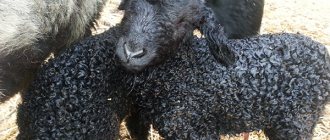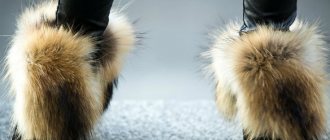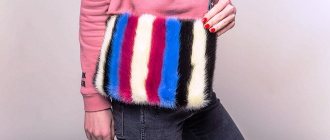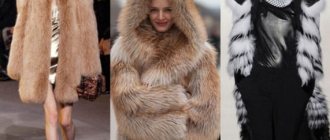At all times, fur products were worth their weight in gold. A fur coat not only protected its owner from bad weather, but also testified to financial well-being and importance in society. Karakul gained popularity at the end of the 19th century and is still found in the collections of leading clothing designers. This fur is represented by many types, the most famous of which are astrakhan fur and broadtail.
History of the origin of karakul
The Karakul sheep was one of the first animals that people started breeding for their fur. The animal was distinguished not only by its beautiful fur, but also by its special unpretentiousness, which allowed it to perfectly adapt to the difficult living conditions in the desert.
The ancestor of all Karakul sheep comes from Uzbekistan, in the past – the Khorezm Khanate. The name of the fur also comes from those places. Translated into Russian, “karakul” means “black lake”. It was near this reservoir, located near Bukhara, that Karakul sheep began to be bred.
For many years, the right to breed these animals and produce expensive and beautiful fur belonged exclusively to the Bukhara Khan. And only many years later, already at the beginning of the 20th century, several individuals were sent to North Africa, in particular Namibia, where today, thanks to new technologies, a special type of karakul called “svakara” is made.
Drying
Before sending the sheepskin to dry, it must be combed with a comb or an animal brush. The skin should be dried away from heating devices and direct rays of the sun. It is better in the shade, in a room with good but not strong ventilation. You need to regularly stretch the skin with your hands, otherwise it will shrink in size.
The back side of the skin will be a little rougher and harder after washing. To get rid of this, you also need to knead it periodically. Leave the sheepskin like this until it dries completely. It cannot be folded; it can only be dried flat. Otherwise, it will be difficult to unfold later.
Karakul and broadtail - what's the difference?
It is known that karakul is made from the skins of newly born lambs of the karakul breed. For this process, individuals 1–3 days old are used. After all, the older the lamb, the coarser the wool. Each skin surprises with its special unique pattern, extraordinary lightness and silkiness.
However, not every person who is not involved in fur production issues will correctly answer the question: broadtail - whose fur?
Karakulcha is the same skins of lambs, but not yet born. It is not difficult to distinguish it from astrakhan fur: the curls are not yet formed, the hairs are short and tightly adjacent to each other, the skin has a beautiful moire pattern.
These two types of fur differ not only in origin, but also in consumer characteristics.
| Characteristics | Astrakhan | Broadtail |
| Appearance | The fur is dense, the curls are clear and fully formed. There is fur of silver, golden, black color. The rarest colors are brown and white. The skin is silky and very soft to the touch. | Unique moire pattern, not fully formed curl. The skins are small in size. Color black, gold or silver. |
| Thermal conductivity | Thanks to the dense core, it retains heat well and is not afraid of moisture. Excellent protection from the cold if the frost is not lower than -10°C. | The density of broadtail is much lower, so products made from this material are not suitable for wearing in winter. |
| Wear resistance | Durable material, excellently withstands use for 10 seasons. Fur is not wear-resistant. | Clothing made from astrakhan fur lasts no more than three years. |
| Usage | Coats and jackets, collars, men's and women's hats are made from astrakhan fur. | It is used for light coats and jackets, but most often as a trim for dresses, coats, and suits. Usually these are exclusive products intended for publication. |
Degreasing
Zh.K = 10, temperature of the washing solution 40 - 42 degrees. Duration 1 – 2 hours. Ingredients: washing powder 5 g/l for fine wool skins (or paste - 6 g/l), for semi-fine wool powder 4 g/l, for semi-coarse - 3 g/l, formaldehyde 0.5 g/l, soda ash 0.5 g/l l. Continuous mixing in the longboat. Home craftsmen can use a washing machine to do laundry. After an hour, the skins are squeezed out and beaten along the hair and flesh with a dead end. Then a second degreasing is carried out in a new solution at a temperature of 42 degrees. In an hour. Rinse in warm water for half an hour.
Types of karakul
Breeders involved in karakul breeding strive to consistently obtain large batches of identical skins that have the specified parameters and characteristics. It is not so easy. After all, the quality of scribble is determined by at least twenty parameters. In addition, fashion dictates its terms, constantly changing the demand for astrakhan of various types and shades. Today, three types of karakul are dominant on the market.
Uzbek karakul
The breed of sheep that supplies this fur was bred by specialists from Uzbekistan. Breeders tried to achieve lightness of fur, relying on the finest astrakhan jacket type with a special pattern. The surface of the skin consists of tight fur curls, forming tubular ridges of varying lengths.
Pros:
- unique design;
- thin light fur;
- fur hairs are pressed tightly against each other;
- strong flesh;
- affordable price.
Minus:
- small size of skins (11 dts2).
Afghan karakul (astragan)
This karakul is produced in Afghanistan. Thick fur of the highest quality is valued much higher than Uzbek fur. Skins usually range in size from 12 to 20 dt2. The fur surface is ribbed and flat, with an extraordinary eye-catching shine. Typically, Afghan karakul has a deep gray tint.
Pros:
- mesmerizing shine;
- thick flesh;
- high strength;
- large skins;
- spectacular fur.
Minus:
- heavy weight of the product.
South African karakul - swakara
This type of karakul is produced in the state of Namibia on the African continent. The surface of the fur is distinguished by amazingly clear parallel flat curls. The skins are canvases similar in thickness to broadtail.
Namibian karakul is the most expensive. It is mainly used to make fashionable coats and jackets for special occasions.
Pros:
- clear ribbed pattern;
- ease;
- small thickness;
- respectability.
Minus:
- high price.
Any high quality scribble is highly appreciated. However, swakara is considered the most expensive and prestigious fur, which not everyone can afford.
Scheme for processing fur sheepskin.
Sequence: soaking, fleshing, degreasing, pickling, tanning, wet grinding, neutralization, dyeing, degreasing of leather tissue, finishing. Fur coats are produced in the same way as fur sheepskins in a continuous process. Homogeneous batches of raw materials are selected.
Soaking is divided into two stages. The sequence, composition of soaking solution chemicals, temperature and time characteristics are the same as for sheepskin fur. Fleshing is standard - in production, in small workshops, flaying is done on flaying machines; home-based craftsmen, when processing a small number of skins, can use a scythe or a wooden block. Degreasing (washing) is standard.
When pickling, either sulfuric acid or organic acid is used, sometimes two acids (sulfuric + acetic or formic). You can apply a stepwise acid supply technology, first with a low concentration and gradually increasing it to the optimal one. Dressing sheep skin involves the use of combined pickling and tanning methods, thereby reducing the dressing time.
Pickling – tanning
L.K = 7, temperature 40 degrees, duration 18 – 20 hours. Composition: mixture of acids - acetic acid 70% - 3 g/l plus sulfuric acid 2.5 g/l, salts 40 g/l, chrome dry tanning agent - 6 g/l, duration 12 hours, skins are often stirred, temperature is kept constant. You can use one sulfuric acid 3.5 g/l (duration 8 hours). Then hyposulfite 2 g/l and chrome tanning agent 8 g/l are introduced. The skins are stirred frequently. After half an hour, soda ash 0.3 g/l, and so on two more times after an hour, 0.3 g/l. After tanning, the leather fabric becomes denser, has a green tint, and the welding temperature is 75 - 80 degrees. Stay for 15 hours. After curing, spinning, drying, rolling in a drum, breaking and polishing the leather. Fur coat skins are dyed with direct or acid dyes.
Features of doodle
Astrakhan fur is distinguished by its unique texture, thickness and silkiness. Any product made from this natural material is unique, since the pattern of curls cannot be repeated. Things made from astrakhan fur look graceful and elegant, and also perfectly repel moisture. Light and warm, they allow air to pass through perfectly, and are as durable as regular sheepskin.
The main advantages of karakul:
- plastic material allows you to create a variety of models;
- ideal for decorating products;
- goes well with fabric and leather;
- allows you to create sophisticated and elegant clothes;
- Astrakhan products are suitable for any figure.
Winter clothing made from astrakhan fur is light and warm, but without special insulation it is hardly suitable for the harsh Russian winter. These are clothes most likely for the off-season, when outside the window is at least -10°C.
Tanning
L.C = 7, temperature 38 degrees, duration 8 – 10 hours. Ingredients: salt 50 g/l, chrome tanning agent (chrome sulfate, basicity 30%) - 8 g/l, after 1 hour add baking soda 1.5 g/l diluted in warm water, after an hour again 1.5 g/l sodium bicarbonate. Stir the skins frequently. The skins are pressed and stored for a day. The dressing of sheep skin will be considered high quality if the skin is tanned to a welding temperature of 75 - 80 degrees. When finished, rinse with powder to clean water.
In production, fur sheepskin is immediately dyed, then the skins are washed and fattened with special fattening industrial compositions. The skins are stretched with hooks on nets or hung on poles to dry; home-based craftsmen stretch the skins on wooden frames and air-dry in warm weather under canopies. After drying, the skins are beaten and rolled in drums. Dry skins are combed, the insides are polished, and finishing work is carried out.
Rules for caring for things made from astrakhan fur
The durability and respectable appearance of the product over the years depends on proper care and compliance with storage conditions in the summer. If your fur coat is significantly dirty, it is better to use the services of a specialized dry cleaner. However, it is quite possible to get rid of small stains and dust at home.
Here are some recommendations for caring for an astrakhan fur coat or coat:
- The surface of astrakhan or broadtail can be wiped with a sponge dipped in a soap solution.
- To remove dust, the product is laid out on a slightly damp sheet with the wrong side up and knocked out with rolled paper or a special plastic beater.
- By wiping the surface of the fur with a cotton pad soaked in a 5% vinegar solution, you can restore the original shine and silkiness.
- Contaminated areas are treated with starch. The greasy stain is covered with powder, lightly rubbed into the pile, and then cleaned with a clothes brush.
- To avoid creases and bald spots, it is not recommended to carry a bag on your shoulder or leave a brooch pinned in one place for a long time.
Under no circumstances should you wash, iron or comb the astrakhan fur. This will inevitably lead to damage to the product.
Scheme for processing sheepskin fur
In practice, several technologies have been developed for the production of sheepskin fur, all of them have been tested and have their own raw material processing schemes. The first operation is sorting the skins. Homogeneous batches are prepared according to the preservation method, hair length, size and type (fine-fleece, semi-fine-fleece, semi-coarse). The skins are weighed; for mechanical longboats, the amount of water is determined based on the given liquid coefficient (LC) and the weight of the dry skins.
Dressing sheep skins involves a continuous round-the-clock process. The processing scheme for sheepskin fur consists of the following operations: soaking, spinning, shearing, fleshing, degreasing, washing, pickling, curing, tanning, curing, dyeing, washing, fatliquoring, drying and rolling. All water-based dressing operations in factories and small workshops are carried out in mechanical longboats. The volume of the longboat depends on the number of skins processed in one cycle. For example, for 5 sheepskin skins, 100 liters is enough.
Questions and answers
How to revive an astrakhan fur coat after a walk in wet snow?
If a fur coat made of astrakhan fur or astrakhan fur gets wet, it must be shaken off, ridding the fur of moisture and snow, and then hung on hangers to dry. Do not dry fur items near heating devices or under a hairdryer. Sudden temperature changes can lead to deformation and damage to clothing.
How to store products made from astrakhan fur or astrakhan fur?
As soon as the winter season is over, the astrakhan fur coat or coat is put away in the closet. The product is hung on wide soft hangers, and a fabric cover is put on top. A continuous supply of fresh air is very important for fur, so the fur coat should hang freely. In addition, care must be taken to protect against moths.
Pickling
Zh.K =7, temperature 35 degrees, duration 14 – 16 hours. Ingredients: salts - 50 g/l, formic acid 6 g/l (you can use acetic acid 70% - 15 g/l or sulfuric acid - 3.5 g/l), for better degreasing, sometimes after adding acid, add kerosene 30 g/l. The skins are stirred frequently. The temperature of the solution is kept constant. Pickling is completed if, when squeezing with your fingers, a white stripe appears at the fold of the flesh - a “dryer”. The skins are squeezed out and laid out to cure for 2 days. Dressing sheep skin, like any dressing, is not complete without the curing operation. During this time, the skins ripen under the influence of a low concentration of acid.
What standards are used in production? What do they take into account?
To comply with the standards described in GOST 2865-68, skins must:
- Be removed in one layer, from head to tail and toes.
- Do not have holes, tears, or snatches from the edges.
- Be thoroughly cleaned of any remaining meat, tendons and fat, and free of ear cartilage, legs and tail;
GOST 8748-70 describes the same thing, and additionally mentions canning conditions:
- The skins must be preserved using a pickled or dry-salted method.
- When dry-salted preservation, they must be thoroughly degreased, cleaned of dirt and blood, the hair roots must not be damaged, they must be straightened evenly.
- When fermented, they must be fermented with bread kvass, have white flesh, and be evenly spread. The fur must be cleaned of all types of contaminants.
Color
In total, there are about 150 shades of astrakhan, making up 3 large groups. The rarer the shade, the more valuable and expensive the color. The most extensive and inexpensive group is black astrakhan fur (furs mainly of Bukhara origin), the second group is brown: cocoa, dark chocolate, bronze, brown, rare ones - amber rum and sur; and silver: antique, maroon, pearl-graphite, guligaz. The brightness of the antique color is compared to the glow of phosphorus in the dark, which adds value to this fur.
Remember our advice when buying an astrakhan fur coat, act slowly - we are sure that you will make the right choice!
What is the price?
Since swakara skins, as material for sewing fur coats, come to the market in very, very limited quantities, the price of the finished product is very high. The main suppliers providing ready-made fur products are Spain, Italy and Greece.
The price range, on average, ranges from 180 to 450 thousand rubles. A Spanish model of a svakara fur coat with a trapezoidal silhouette can be purchased for 190 - 250 thousand, and a Greek model of a classic cut - for 290 - 300 thousand rubles.
[Show slideshow]










